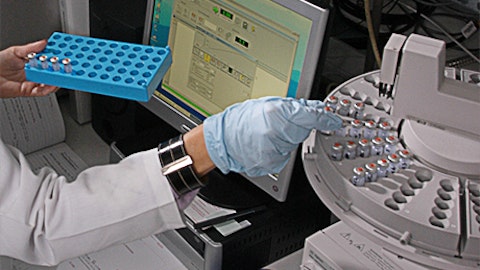Revolution Medicines, Inc. (NASDAQ:RVMD) Q3 2023 Earnings Call Transcript November 6, 2023
Operator: Good day, and thank you for standing by. Welcome to the Revolution Medicines Q3 2023 Earnings Conference Call. At this time, all participants are in a listen-only mode. After the speakers’ presentation, there will be a question-and-answer session. [Operator Instructions] Please be advised that today’s conference is being recorded. I would now like to hand the conference over to your speaker, Erin Graves, Senior Director of Corporate Communications and Investor Relations. Please go ahead.
Erin Graves: Thank you, and welcome, everyone, to the third quarter 2023 earnings call. Joining me on today’s call are Dr. Mark Goldsmith, Revolution Medicine’s Chairman and Chief Executive Officer; and Jack Anders, our Chief Financial Officer. Dr. Steve Kelsey, our President of R&D, will join us for the Q&A portion of today’s call. As we begin, I would like to note that our presentation will include statements regarding the current beliefs of Revolution Medicines with respect to our business and the proposed acquisition of EQRx, including statements regarding our development plans and time lines for our portfolio and pipeline and the expected timing and benefits of the proposed acquisition, all of which are intended to be covered by the safe harbor provisions of the Private Securities Litigation Reform Act of 1995 for forward-looking statements.
These statements are subject to a number of assumptions, risks and uncertainties. Actual results may differ materially from these statements, and except as required by law, the company undertakes no obligation to revise or update any forward-looking statements. I encourage you to review the legal disclaimer slide of our corporate presentation, our earnings press release and all of our filings with the SEC concerning these and other matters. With that, I will turn the call over to Dr. Mark Goldsmith, Revolution Medicine’s Chairman and Chief Executive Officer. Mark?
Mark Goldsmith : Thank you for joining us. I’d like to focus first on our remarkable headline investigational drug, RMC-6236 and try to paint the picture we see based on a couple of important weeks of data updates an extensive dialogue with investigators and clinical experts. First, objectively and by hands-on investigator experience treating over 131 patients so far, RMC-6236 is well tolerated at clinically active doses, including 300 milligrams QD as reported to us by investigators. These observations with the first-ever RASMULTI inhibitor in the clinic, our dogma breaking and demonstrate clearly that this compound has a very sound therapeutic window. Second, this profile is enabling continuity of dosing, which we believe is critical in treating RAS-addicted cancers.
Patients receiving RMC-6236 have required few dose interruptions and even fewer discontinuations for intolerability. This differentiating feature of RMC-6236 is a core lever for evaluating meaningful clinical benefit. Third, despite the inter-patient variability that is typical for oral anticancer agents, RMC-6236 showed dose-dependent increase in exposure at every dose escalation tested up to and including 400 milligrams daily. Fourth, RMC-6236 has shown objective anti-tumor activity, both by radiographic imaging and ctDNA quantitation against three oncogenic RAS gene types for which no other targeted therapy is available, KRAS G12D, G12V and G12R. G12D and V alone account for more than half of all RAS solid tumors. And G12D, V and R mutations are the three most common RAS drivers of pancreatic ductal adenocarcinoma, accounting for nearly 90%.
The results with each of these genotypes individually represents a first-in-class clinical validation for a direct RAS inhibitor and the breadth of activity is simply unique, a true RASMULTI inhibitor. It is not possible to discern any obvious relationship between dose and objective response rate by RECIST at this stage in the study, probably due to small numbers at each dose level and the bias towards short follow-up at the high dose levels. With increased numbers of patients now enrolled and ongoing maturation of the data, we expect to be able to conduct a robust exposure efficacy analysis using several outcome measures. The blended objective response rate in non-small cell lung cancer is already solid at 38% in the data we shared in October.
Some patients are expected to develop a partial response after the first scan, we anticipate this number settling out in the 40% to 50% range at recommended Phase 2 dose and objective response rate in lung cancer generally correlates with progression-free survival. So we plan to select a candidate dose to discuss with the regulators and execute the foundational work to enable a pivotal Phase 3 trial in second-line RAS-mutant non-small cell lung cancer to begin in 2024, and while we continue collecting durability data. The blended objective response rate in pancreatic ductal adenocarcinoma and the data we shared in October was a respectable 20% and which may change as we gather more data at higher doses, follow patients on treatment longer and hone in on a go-forward dose.
One relevant benchmark for comparison we’ve highlighted is the objective response rate for cytotoxic chemotherapy that has been reported across many studies in second-line pancreatic cancer, which hovers in the 7% to 11% range. Notably, most patients treated in the RMC-6236 study so far have had two or more lines of treatment previously, making them third-line or later by definition. In the context of third-line or later, the reported objective response rate has been zero to 4%, while the response rate for such patients in our study was at higher-higher than the overall 20% number. For all of these reasons, our expert advisers, and we believe that RMC-6236 is performing well by this standard for patients who are facing grim prospects with standard of care.
While these objective response rate observations are encouraging, we continue to emphasize that objective response rate is not the key clinical endpoint for pancreatic ductal adenocarcinoma since rapid progression with short overall survival is the norm, even in those who respond initially to established treatments. We expect that doctors, patients, regulators and payers will be driven by durability of clinical benefit as indicated by progression-free survival and overall survival. Median progression-free survival for standard second-line pancreatic ductal adenocarcinoma treatment consistently has been reported to be approximately three months and may be shorter for patients beyond second-line. It’s too early for us to project these parameters for RMC-6236, and it will take some time into 2024, for us to be able to establish a true median PFS.
But here, there are also encouraging signs. The disease control rate we shared in October was 87% and significantly higher than most reports for salvage chemotherapy in pancreatic cancer. Many patients on study have already crossed the median PFS threshold mentioned above and remain on treatment, including as far out as 48 weeks. This statement is true even for patients who have not yet shown an objective response. 20% of patients without a partial response were still on drug at 18 weeks, with many of these 20% having reached 21 or more weeks while continuing on drug, well past the short duration benchmark for second-line pancreatic ductal adenocarcinoma. Even the few patients with a partial response who progressed did so at 18 weeks or later.
These are highly encouraging findings. Finally, we believe we have a proposed recommended Phase 2 dose for lung cancer in hand now, and expansions are underway to develop a robust data set we think is needed to satisfy project Optimus. We have strong conviction about the potential clinical impact of RMC-6236 and serving the real unmet needs in lung cancer and with continuing consultation with advisers and engaging as appropriate with regulators, in 2024, we expect to initiate a pivotal Phase 3 monotherapy second-line non-small cell lung cancer trial focused on achieving full regulatory approval and with a potential accelerated approval opportunity built in via an interim analysis. Investigators globally are highly interested in participating in this study.

We are likewise excited about the potential for RMC-6236 in pancreatic cancer, where unmet needs are certainly profound. Here, PFS is the gating parameter for advancing into late-stage development since ORR is an unreliable predictor of durability. We expect to establish RMC-6236 durability profile via median PFS and identify a recommended Phase 2 dose in 2024. With that in hand and continuing consultation with advisers and engaging as appropriate with regulators, we are designing a pivotal monotherapy trial in pancreatic cancer, potentially to be initiated in 2024. Our base plan currently is a Phase 3 randomized trial for second-line treatment, but we are also evaluating options that could accelerate our reach into first-line. Investigators globally are highly interested in participating in this study or studies as well.
Next, I’d like to comment on our exciting second investigational drug to show clinical activity, RMC-6291 for KRAS G12C cancers and try to paint the picture we see based on the recent update and extensive dialogue with investigators and clinical experts. First, objectively and by investigators who have treated more than 63 patients so far, RMC-6291, is well tolerated across a wide range of clinically active doses, and so far, investigators report that it is well tolerated. Asymptomatic prolongation of QTC on electrocardiogram has been seen in some patients, only infrequently exceeding the 500 millisecond threshold. Investigators broadly do not consider this laboratory finding, a key limiter to clinical development of this compound. Second, good tolerability enables continuity of treatment and patients receiving RMC-6291 have required a few dose interruptions and even fewer discontinuations for intolerability.
Third, 6291 has shown objective of antitumor activity, both by radiographic imaging and ctDNA quantitation in both non-small cell lung cancer and colorectal cancer. Notably, in lung cancer, the ORR and the data we shared in October was 50% in patients who had recently progressed on prior treatment with an approved KRAS G12C(OFF) inhibitor. The only comparable reported data in similar patients using a G12C(OFF) inhibitor showed an objective response rate of 7%. Similarly, the ORR for single-agent RMC-6291 was 43% in colorectal cancer patients who had not yet experienced a RAS inhibitor, similar to reported data from G12C(OFF) inhibitors when used in combination with anti-EGFR antibodies. These results indicate two dimensions of clinically meaningful differentiation from other KRAS G12C inhibitors.
This differentiation is highly encouraging for the potential of RMC-6291 itself as a drug, and it supports our preclinical prediction that inhibition of the RAS(ON) state in a human tumor may be biologically differentiated relative to inhibition of the RAS(OFF) state. Further, we believe this paradigm likely applies across our portfolio of RAS(ON) inhibitors boosting the probabilities of success across our entire deep pipeline. Fourth, based on these findings, we believe that RMC-6291 is an investigational drug with a profile that deserves to be evaluated in a late-stage development program. There remains several options to be considered and strategic decisions will need to be made among them based on further data we are collecting. These include monotherapy approaches built directly upon the differentiated response profile described above, and we are currently conducting monotherapy dose optimization with the goal of selecting the single-agent recommended Phase II dose with a project optimist data package that supports it.
We are also committed to evaluating several compelling combination options very soon, and indeed have already begun recruiting for the exciting pairing of RMC-6236 plus RMC-6291 based on compelling preclinical observations. In aggregate, these findings are highly encouraging and point to large opportunities ahead for these first two compounds. Based on this momentum, we look forward to completing the acquisition of EQRx. Let me summarize the status briefly. We expect to acquire EQRx in an all-stock transaction to gain an estimated $1.1 billion in additional net capital after estimated post-closing EQRx wind down and transition costs, a significant quantum of capital that can be deployed for Rev Med programs and more than we had estimated conservatively when we signed the deal.
Our strengthened balance sheet is intended to enable the larger investments needed to support the parallel data-driven, late-stage development for our RAS(ON) inhibitor pipeline focused initially on RMC-6236, 6291 and 980. Our shareholder meeting to vote on the transaction is scheduled for November 8, 2023, at 11:00 a.m. Eastern time, and the deal is expected to close shortly following the shareholder vote subject to satisfaction of customary closing conditions. The stock exchange ratio determined and announced last week was as follows, each common share of EQRx outstanding will be exchanged for 0.1112 common shares of Rev Med. We estimate we will be issuing approximately 55 million new shares to EQRx shareholders as part of this merger, thus acquiring approximately $20 in estimated net capital per share of the common stock issued in connection with the merger based on our updated net cash projection.
Revolution Medicines will continue to focus on our mission to revolutionize treatment for patients with RAS-addicted cancers through the discovery, development and delivery of innovative targeted medicines. Now let’s hear from Jack Anders, our CFO, regarding our Q3 financials. Jack?
Jack Anders : Thank you, Mark. Turning to our third quarter financials. We ended the quarter with $813.2 million in cash, cash equivalents and investments. Please note, this balance does not include any net proceeds from the anticipated acquisition of EQRx, which is expected to add approximately $1.1 billion in net cash proceeds should the transaction close. Total operating expenses for the third quarter of 2023 were $123.2 million. The increase in operating expenses over the prior year period was largely due to clinical trial and manufacturing expenses for RMC-6236 and RMC-6291, an increase in research expenses associated with our preclinical portfolio and an increase in personnel-related expenses resulting from additional headcount.
GAAP net loss for the third quarter of 2023 was $108.4 million or $0.99 per share. We are updating our financial guidance and expect full year 2023 GAAP net loss to be between $385 million and $415 million, which includes estimated noncash stock-based compensation expense of $45 million to $50 million. The increase in GAAP net loss guidance is largely due to the anticipated acceleration of a portion of RMC-6236 manufacturing spend originally planned for 2024. This spend was accelerated as a result of the progress in our RMC-6236 program. We reiterate cash runway guidance into 2025 based on our current plan. Please note that our current financial guidance excludes the impact of the proposed EQRx transaction. And with that, I’ll now turn the call back over to Mark.
Mark Goldsmith : Thank you, Jack. We believe Revolution Medicines has an unprecedented opportunity to deliver high-impact benefit to patients through our pipeline. And toward that goal, the deal with EQRx will markedly enhance our ability to bring the most out of these exciting compounds. We have heard broad and strong support for the Rev Med portfolio approach and proposed transaction. The board and management of Rev Med encourage all of our shareholders to vote in favor of the EQRx transaction. The employees of Revolution Medicines renew our deep commitment to out smart cancer on behalf of patients and to build share value for our investors.
Operator: [Operator Instructions]. Our first question will come from Marc Frahm of TD Cowen. Your line is open.
See also 15 Most Profitable Airbnb Cities in the World and Top 20 Richest Football Leagues in the World.
Q&A Session
Follow Revolution Medicines Inc. (NASDAQ:RVMD)
Follow Revolution Medicines Inc. (NASDAQ:RVMD)
Marc Frahm : Hi, thanks for taking my question. I recognize it’s not been a lot of time since the data cuts that were presented back at ESMO and EMA, but there were a few patients who were unconfirmed but ongoing in partial responses at that time. I’m not sure if you’re able to update if some of those have been able to have subsequent scans and that can actually confirm. And then maybe a bigger philosophical question. Over those meetings, we also saw — and in the last few months, we’ve seen a handful of trials take on docetaxel in the second-line setting, lung cancer, a handful of different settings within lung cancer. And often, drugs that look pretty promising, have struggled a bit to or even failed to beat just the tax. Just philosophically, since the safety profile looks really good. Why be aggressive and take just tax-on straight-on instead of trying to combine with this taxi since that would seem to be a much easier hurdle on an efficacy side.
Mark Goldsmith : Thanks a lot, Marc. I appreciate your questions. Let me comment first on the question of confirmations. A number of those patients really had just squeaked in, in the advanced period we required in order to report them, which means that they just had one scan. And it’s only been a couple of weeks since then. So I think for most patients, we just don’t have any more information, so I can’t really provide an update today. The question of docetaxel as a comparator versus for a monotherapy trial versus waiting for a combination? Well, I think in part the question answers itself a little bit, but maybe Steve Kelsey can give you a little bit more philosophy on that.
Steve Kelsey : I think, Marc, the principle, which we’re trying to carry through the whole portfolio, irrespective of lines of therapy is we would like to get chemotherapy out of the equation if we possibly can. And so a good starting point would be a single agent study against dose attacks all to try and beat it, really. I think leaving chemotherapy like docetaxel in the sort of therapeutic alimentarium for patients is suboptimal. And I think that we would just rather try and beat it at hands down and relegate the dose attacks into later line of therapy, frankly. I appreciate that it is certainly an option to do a dose tax in both arms, but that’s not really the philosophical basis of our portfolio.
Marc Frahm : Okay. Thank you.
Operator: And one moment for our next question. Our next question will be coming from Eric Joseph of JPMorgan. Your line is open.
Eric Joseph : Hi, good evening. Thanks for taking the question. I just wanted to try and get a little more incremental color on the tolerability profile that you’re observing at the 400-milligram cohort and whether you see room to further dose escalate now that 500 milligrams is something that you were contemplating — and — just as we think about your backfilling of some of the previous dose cohorts. Can you just kind of elaborate a little bit on your sort of strategy there? What cohorts you’re prioritizing perhaps whether you’re opening the criteria up for patients with G12C mutation, and perhaps also just sort of how colorectal cancer patients might sort of fall within that scope. Is that a histology you’re keen on sort of revisiting here within the Phase 1 study? Thank you.
Mark Goldsmith : Thanks a lot, Eric. I’ll take the first question, and Steve can comment on a second. The first about tolerability. We don’t really have any incremental information compared to what we just reported two weeks ago. And as you know, once we have the information was submitted to the dose selection committee, and they’ll determine where we are with it, whether or not it’s a good dose, whether or not we should advance the dose, those determinations will be made in the right time frame with the right data. The second question, I think the question really was how are we — what are the — what’s the range of options that we’re looking at for combinations in the — over the next 12 months? And how would we prioritize those?




